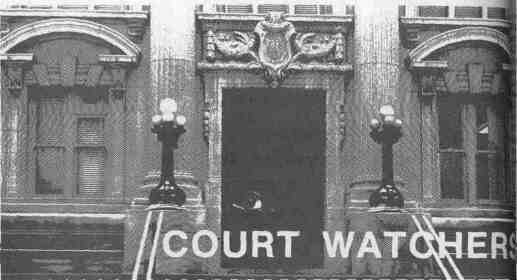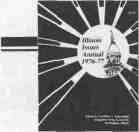A teacher and free-lance writer living in Chicago, he is the author of numerous articles and children's books. His first article on courtwatching, in Cook, Champaign, Warren and DuPage counties, appeared in Illinois Issues, August 1976.
During the three years, from the fall of 1974 to the fall of 1977, over 700 court watchers observed approximately 82,000 proceedings in 81 courtrooms. They observed 152 different judges, as well as hundreds of assistant state's attorneys, bailiffs, public defenders and other court personnel. The project director was Barbara Fenoglio, ex-reporter for the Milwaukee Journal. "In the past, judges and lawyers have thought the courtrooms were solely their domain," Mrs. Fenoglio said. "I think the chief accomplishment of our project is we have reminded them that the community is watching and cares what happens there." Before the League court watchers arrived, virtually no one was watching our state's courts. No government agency observes Illinois courts on a regular basis. Court watchers, both male and female, comprised a cross-section of Illinois citizens. They included retirees, housewives, secretaries, social workers, teachers, factory workers, a bartender, a farmer, a corporate planner — all working on a volunteer basis. Apprentice court watchers were educated by lawyers and project staff members on how a courtroom should be run, according to Illinois law. Armed with questionnaires, the court watchers went to work monitoring courtrooms in their home counties. Each day they filled out reports regarding courtroom procedures and personnel, and at the end of the year the data was collated, county by county. The findings — along with suggestions — were then presented to judges, the ILEC, the Administrative Office of the Illinois Courts, the Illinois State Bar Association, and other judiciary agencies. Reports on judges who may have acted improperly were sent to the Illinois Judicial Inquiry Board. "One judge kept referring to us as the 'League of Women Weight Watchers,'" said Mrs. Fenoglio. "But almost all of the 152 judges whose courtrooms we've observed have been cooperative." In 1975, the first year of the project, 259 court watchers observed 60,000 misdemeanor proceedings in four Illinois counties. (See " Court watching project: Is justice being done in Cook, Champaign, Warren & DuPage?" August 1976, p.3.) The court watchers were asked this key question at the end of each day's proceedings: Were you left with the feeling that justice was being fairly administered?
In Warren County 97 per cent answered
"Yes." In Champaign County 95 per
cent answered "Yes." In DuPage 86 per
cent answered "Yes." In suburban Cook
County, 87 per cent answered "Yes," but
in the Cook County courts of Chicago,
less than half the observers felt that
justice was being administered. The key
problems — especially in the high crime
area of Chicago — were unnecessary
continuances, lack of communication
between citizens and legal personnel
and overcrowding. The project proposed
solutions, several of which have
already been adopted. Calendars and
defendants' rights have been posted in
some courts. Bailiffs have received more
extensive training. Most importantly,
court watchers reported that some
judges have become stricter about al- 16/ March 1978/ Illinois Issues Continued from page 16. lowing continuances. In 1976, the project's second year, the court watchers mainly observed preliminary hearings for felonies. Over 300 monitors watched 27 courtrooms in Cook, DuPage, Champaign, Warren, St. Clair, Rock Island, and Winnebago counties. Court watchers were once again asked if they felt that justice was being fairly administered. The results showed a surprising improvement, especially for Cook County. In Cook county suburban courts, 90 per cent answered "Yes," while Chicago courts had an 88 per cent "Yes" response. The other three counties watched for the second consecutive year all showed improvement: 93 per cent "Yes" in DuPage, 96 per cent in Champaign and 100 per cent in Warren. The lowest percentage of "Yes" answers was 75 per cent St. Clair County. The other two counties covered for the first time in 1976 both received high marks: Winnebago had 97 per cent "Yes" and Rock Island had 96 per cent. Why did the felony courts get a better report than the misdemeanor courts did the year before? "I think felony courts are run better than misdemeanor courts," said Peggy Neuliep, assistant director of the court watching project. "The more serious the crime, the more careful the courts seem to be." Vera Roden, a Chicago court watcher, agreed that more care is taken in felony cases. "A man who can go to jail for raping or killing someone has a lot more to lose than someone up for a shoplifting misdemeanor," she said. "The volume in misdemeanor courts is at least three times bigger, which also makes just decisions more difficult." Has the very presence of the court watchers helped the process of justice? Ethyle Hilkevitch has been a court watcher in Evanston for three years. "I would hope we could put court watchers in every court every day," said Mrs. Hilkevitch. "Our being there is a deterrent to any abuse within the judicial system." William Madden is the deputy director of the Administrative Office of the Illinois courts, which conducts studies and surveys of our courts. He said, "Everybody in the court system — judges, clerks, bailiffs, attorneys, even janitors — function a little bit better when they they know an informed person is there to observe and evaluate what's going on. Although most 1976 court watchers thought that justice was being served, they still had complaints. Continuances (delaying a case to another day) were one of the biggest complaints. Statewide, almost half of all cases observed were continued. In Cook County, 58 per cent of the 6,528 preliminary hearings watched were continued. Only 1.5 per cent of all continuances requested were denied. In DuPage, 31 per cent of the cases were continued, and in Winnebago, 29 per cent were continued. The court with the highest rate of continuances was the Niles court in Cook County, where 74 per cent of all preliminary hearings observed were delayed to another day. The East St. Louis court in St. Clair County was close behind, at 73 percent. Preliminary hearings on felonies determine whether there is "probable cause" for the defendant to be prosecuted. At the actual trial, more continuances may be granted. With all these delays, it can sometimes take years for a case to be settled, so that justice may have gray hair before she (hopefully) triumphs. 'Everybody in the court system — judges, clerks, attorneys, even janitors — function a little bit better if they know an informed person is there to observe what's going on' Many people mistakenly think that it is the defense lawyers, playing for time, who always ask for continuances. But according to Barbara Fenoglio: "In Cook County and DuPage the prosecution was responsible for more continuances than the defense. Sometimes lab reports were not back in time for the trial. Sometimes state's attorneys were unprepared. The state's attorneys seem overburdened, and it appeared to the monitors that there weren't enough of them. We have recommended that the Illinois attorney general provide training for assistant state's attorneys." The project also recommended that judges observe Illinois Supreme Court Rule 16, which states that judges should try to "...expedite the disposition of matters before the court."
The League's 1976 report. Citizens
Size Up Their Courts, describes many
other problems, findings, and recommendations regarding the state's circuit
courts. This report is free and may be
obtained by writing to: Illinois Law Enforcement Commission In 1977, the last year that the program was funded by the ILEC, 344 court watchers observed a variety of cases in 15 counties (Adams, Bureau, Champaign, Cook, DuPage, Jackson, Kane, Kankakee, Knox, Macon, McHenry, McLean, Warren, Will and Winnebago). "Since this was the last year of funding from ILEC," Mrs. Fenoglio said, "we have prepared local court watching groups to go on by themselves. This year experienced local groups zeroed in on what they wanted to watch. Some court watching groups will continue." At the end of 1977 — its last year as a statewide, funded entity, the project made a number of final recommendations to the ILEC and the various other Illinois judiciary agencies. Most of these suggestions are intended to reduce the time and eliminate the confusion that occur in many of our state's courts. As always, a primary suggestion was that judges be more strict about granting continuances. Another suggestion was that the Illinois Supreme Court authorize a pamphlet explaining defendants' rights in everyday language (pamphlets for victims and witnesses were also recommended). A third recommendation was that judges clearly explain to defendants the meaning and consequences of a guilty plea. The project also suggested that all judges clearly explain courtroom procedures to involved parties in an opening statement (many judges already do this, but others mutter their opening statements in a cursory or disinterested way). Other suggestions: that the physical facilities of the courts be improved so that people can hear and feel at least semi-comfortable; that defendants throughout Illinois be allowed to wear their own clothes at trials, because the wearing of jail clothes might be prejudicial to their cases; that a uniform March 1978/ Illinois Issues/ 29 standard be established throughout the state for assigning public defenders to those who request them; and that more assistant state's attorneys receive better training throughout the state. Besides these suggestions, volunteers from the League court watching project have offered to operate information desks outside high-volume courtrooms. Although the project is over as a statewide effort, court watching in some counties will continue. "Groups continuing include those in Macon County, Champaign County and St. Clair County — all done on a volunteer basis," said Mrs. Fenoglio. Late in December 1977, a grant was issued by the ILEC to the League of Women Voters of Cook County to fund their court watching project for another year. Mary Kay Gage, who has watched Cook County misdemeanor and felony courts for two years, thinks that the continuation of individual court watching projects would be a boon to all Illinois citizens. "Picture yourself walking into the court for the first time," she said. "You're frightened, confused by legal terminology and bewildered by the speed and impersonality of court procedures. Citizens are paying for our judicial system, and citizens are entitled to their money's worth. Many observers feel that when a court watcher is there, court personnel try to do their jobs a little better." William Madden of the Administrative Office of the Illinois Courts also expressed hope that individual projects would continue: "When these court watchers leave the courts, they're our biggest boosters. They see our lack of manpower and our lack of facilities. For instance, in Cook County some of our courts are literally pigsties. I think the League watchers see this and ask why something isn't done. Also, they are helpful in their forthright criticism of individual judges. When they do criticize judges, they have been right 9 times out of 10 — make that 10 times out of 10." The League's goal, according to Mrs. Fenoglio, "is to put a court watcher in every trial courtroom in Illinois. We'd need over a thousand volunteers." It's certainly a worthwhile goal. If citizens do not take an active interest in our courts, then how can we complain about the things that happen to us in those courts?
30/ March 1978/ Illinois Issues |
|||||||||||||||


